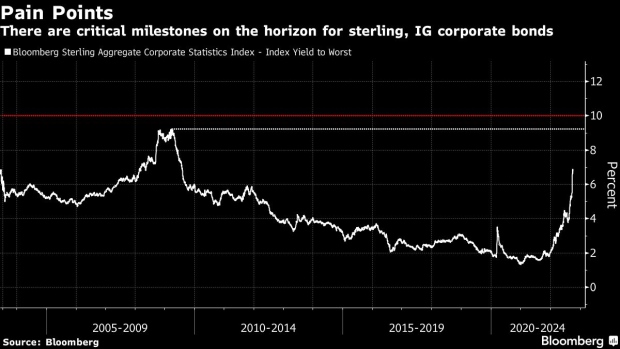Sep 30, 2022
The Market Pain Levels That May Spark the Next UK Policy Action
, Bloomberg News

(Bloomberg) -- The Bank of England’s emergency action has restored a semblance of order to the UK’s financial markets, yet the next pain threshold may not be too far away.
The respite from the BOE’s billions in bond-market buying in the past two days has already proved somewhat fleeting. Government debt and the pound keep swinging between gains and losses, while the cost of insuring against a UK default is at the highest since the Brexit vote in 2016.
With new Prime Minister Liz Truss sticking to plans for borrowing-fueled tax cuts, which sparked this week’s record low in the pound and historic spike in debt yields, Wall Street banks have been lining up to question the country’s finances and call for more policy action.
Here’s a look at some looming market levels that might spark another response from UK officials.
Pound Parity
A move below parity with the dollar for the first time ever would be a bruising embarrassment for Truss, and a clear emblem of the drop in the UK’s standing. It could also have serious political implications, with the Telegraph newspaper reporting the level would leave her facing a rebellion from Tory lawmakers against the tax cuts.
While the pound has recovered to trade around $1.10, the moves in recent days show how quickly it can collapse in the wrong conditions. Options imply around a 1-in-3 chance of the currency hitting parity by year-end, and the recent rise may actually make it cheaper for traders to bet on it.
‘Pound Reset’ Puts Parity In Sight for Another Wall Street Bank
“Approaching 1 is clearly a psychologically significant point,” said Lyn Graham-Taylor, a strategist at Rabobank, adding that the depreciation of the pound has to be taken into account by the Bank of England as it aggravates inflationary pressures. “I think the market will test the willingness of the BOE to aggressively hike rates.”
Gilt Pain
For government bonds, what may matter more than any outright level is trading conditions. Antoine Bouvet, a strategist at ING Groep NV, noted that average bid-ask spreads across most gilts have improved since the BOE’s intervention, but on longer maturities liquidity remains strained.
A liquidity index for gilts suggests trading conditions are the worst since 2011. If conditions remain poor or get worse once the BOE stops buying, it may give officials an excuse to continue to intervene on financial stability grounds.
Britain’s Crisis of Confidence Was Years in the Making
Looking further ahead, another pressure valve may be hit if the central bank pushes ahead with delayed plans to sell down its bond holdings.
“For them to do buying now, then turn around and sell two weeks later and then deliver a significant monetary policy rate hike, seems a difficult proposition,” said Rohan Khanna, a rates strategist at UBS Group AG.
Mortgage Crisis
Yields on two-year interest-rate swaps, which lenders use to price mortgages, hit nearly 6% this week amid the market volatility. The cost of most two-year UK mortgages are still well below this level, at around 3% to 5% depending on the credit worthiness of the borrower.
The gap between the two can only be sustained until lenders exhaust their hedges, following which mortgage rates will have to raise dramatically in order for banks to avoid writing loans at a loss. The cost of borrowing to buy a home is already at its highest level since the financial crisis.
Further increases are inevitable as interest rates rise to deal with inflation. But a sudden spike would threaten the political capital the Conservative party has invested in home ownership and the housing market.
The Cost of an Average UK Mortgage Could Rise 70% by March
Credit Warnings
Alarm bells have already gone off in the sterling credit world, with the cost of refinancing for sterling-denominated investment grade bonds at the highest-ever level. But even as yields head for their biggest monthly increase on record, there’s another, more dire milestone on the horizon.
At 6.6%, the yield is about 260 basis points away from matching the gauge’s all-time high of 9.23%, a level reached in 2009 in the aftermath of the global financial crisis, according to a Bloomberg index. Given recent market moves, that could happen in a matter of weeks.
A push above 10% would send panic waves throughout the market. Any move into double digits, more akin to emerging markets, would be a shock for investors given that the gauge tracks the safest sterling corporate notes, and would put borrowers in an unprecedentedly risky position.
©2022 Bloomberg L.P.





